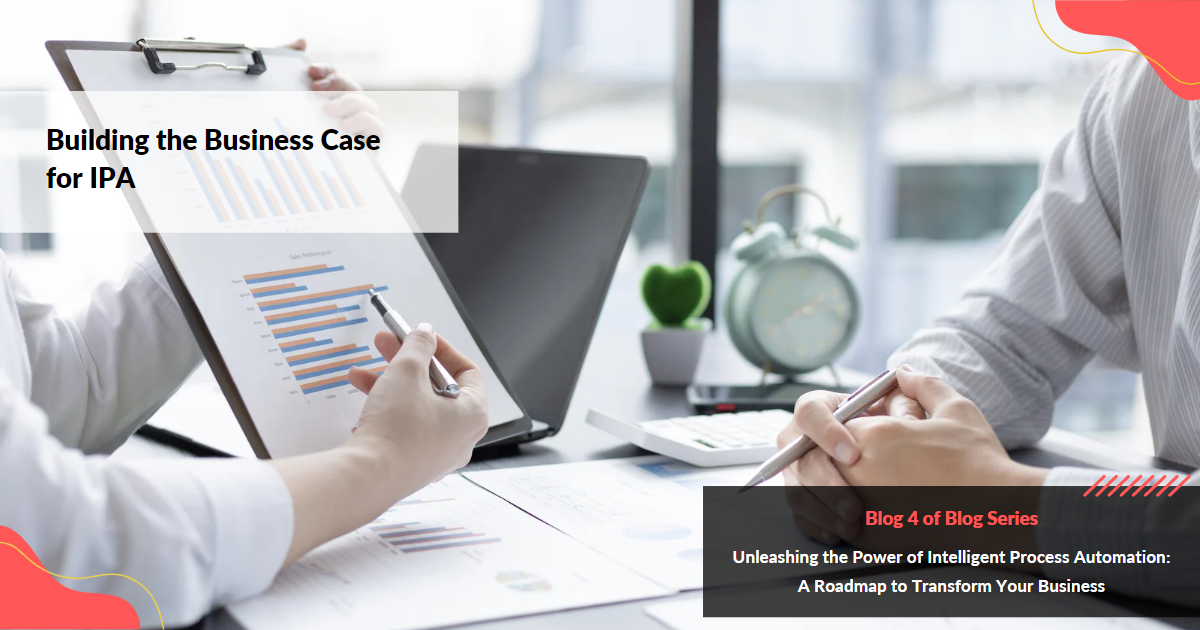Introduction
Are you ready to unlock the true potential of Intelligent Process Automation (IPA) and transform your business? Welcome to the fourth blog in our exciting 7-series, “Unleashing the Power of Intelligent Process Automation: A Roadmap to Transform Your Business.” In this blog, we dive deep into the crucial step of building a compelling business case for IPA.
Previously we assisted you in deciding if IPA is the right solution for business processes you want to automate, by walking you through a feasibility analysis process. But now that you’re convinced that IPA is right for your business processes, here’s the next challenge on your path to achieve seamless efficiency: How do you convince stakeholders, secure the necessary resources, and ensure a successful IPA implementation?
We’ve got you covered! This blog is your ultimate guide to mastering the art of building a persuasive business case for IPA.
Get ready to unleash the full potential of IPA and position your organization for long-term success in this ever-changing business landscape. Together, we will embark on the next step of our automation journey: “Building the Business Case for IPA.”
Let’s dive right in and discover the secrets to building a compelling business case for IPA!
Section 1: Understanding the Business Case
In order to successfully implement Intelligent Process Automation (IPA) within your organization, it is crucial to build a compelling business case. This section explores the concept of a business case and its role in presenting a persuasive argument for IPA implementation.
1.1 Defining the Business Case
A business case is a documented proposal that outlines the benefits, costs, and risks associated with a particular project or initiative. It serves as a roadmap for decision-makers, providing them with a comprehensive understanding of the value and feasibility of the proposed solution.
1.2 The Benefits of Building a Business Case
Building a robust business case for IPA offers several key benefits:
Organizational Support: A well-crafted business case helps gain support from key stakeholders and decision-makers within the organization. It provides them with a clear understanding of the potential benefits and value of IPA, fostering alignment and collaboration.
Resource Allocation: By presenting a compelling business case, you can secure the necessary resources, including budget, technology, and talent, required for successful IPA implementation. This ensures that the project has the support and backing it needs to thrive.
Project Success: A comprehensive business case helps mitigate risks and uncertainties by identifying potential challenges and addressing them proactively. It enhances the likelihood of project success by providing a structured approach and guiding the implementation process.
1.3 Aligning with Strategic Objectives
To build a compelling business case for IPA, it is crucial to align the proposed automation initiatives with the strategic objectives of your organization. By demonstrating how IPA can contribute to achieving overarching goals, such as improving operational efficiency, enhancing customer experiences, or increasing profitability, you create a strong connection between the automation initiative and the organization’s vision.
1.4 Demonstrating the Value Proposition of IPA
One of the key aspects of a business case is showcasing the value proposition of IPA. This involves highlighting the potential benefits, such as cost savings, increased productivity, reduced errors, and improved scalability. By quantifying the expected return on investment (ROI) and illustrating how IPA can drive tangible business outcomes, you can make a compelling argument for its implementation.
Section 2: Articulating the Benefits of IPA
Intelligent Process Automation (IPA) offers a multitude of benefits that can revolutionize your organization’s operations. In this section, we will explore the key advantages of IPA and how it can address specific pain points and challenges within your organization.

2.5 Case-Study
To illustrate the tangible benefits of IPA implementation, you should consider some real-time examples and compare your use case with their implementation of IPA.
For example, if you’re an automobile dealer, case studies of IPA implementation in your industry should be marked as high-value resources for your business case. For instance, here’s a case study of a major Automobile company that recognized that their manually operated quote processing system hampered customer experience and lowered their sales rate. It took days to respond to a single customer with a quote. With automation they were able to achieve an average quote response time of less than 30 minutes.
Section 3: Aligning with Organizational Goals
To build a compelling business case for Intelligent Process Automation (IPA), it is essential to align it with the overall goals and objectives of your organization. In this section, we will explore the significance of aligning the business case with organizational goals and provide guidance on how IPA can support strategic initiatives, drive digital transformation, and contribute to long-term success.
3.1 Strategic Alignment
Aligning the business case for IPA with your organization’s strategic goals is crucial for its success. IPA can act as a catalyst for achieving strategic objectives by streamlining processes, improving efficiency, and driving innovation. Whether your organization aims to enhance customer experiences, increase operational efficiency, or expand into new markets, IPA can be leveraged to support and accelerate these strategic initiatives.

3.2 Driving Digital Transformation
In today’s digital age, organizations are undergoing digital transformation to stay competitive and meet evolving customer expectations. IPA plays a pivotal role in driving digital transformation efforts by automating manual and repetitive tasks, digitizing workflows, and enabling data-driven decision-making. By embracing IPA, organizations can unlock new levels of operational agility, improve business agility, and position themselves as technology leaders in their industry.
3.3 Long-Term Success
Building a strong business case for IPA involves considering the long-term impact and sustainability of the automation solution. IPA can contribute to long-term success by creating a foundation for continuous improvement, scalability, and adaptability. As your organization grows and evolves, IPA can be expanded to automate additional processes, integrate with new technologies, and drive further optimization. This long-term vision ensures that the benefits of IPA extend beyond immediate gains, setting your organization on a path of sustainable success.
3.4 Identifying and Mapping Organizational Goals
To align the business case with organizational goals, it is crucial to identify and map the specific goals that IPA can help achieve. Start by understanding your organization’s strategic objectives, departmental goals, and key performance indicators (KPIs). Then, assess how IPA can contribute to these goals by streamlining processes, improving efficiency, reducing costs, and enhancing customer experiences. Consider the potential impact of IPA on revenue growth, customer retention, employee satisfaction, and overall business performance.
By mapping the benefits and value proposition of IPA to specific organizational goals, you can create a compelling narrative that highlights the direct correlation between IPA implementation and achieving strategic objectives. This alignment strengthens your business case and demonstrates the strategic importance of IPA for your organization’s long-term success.
Section 4: Assessing Costs and ROI
In building a robust business case for Intelligent Process Automation (IPA), it is essential to thoroughly assess the costs and potential return on investment (ROI) associated with its implementation
4.1 Assessing Costs
When assessing the costs of IPA implementation, it is important to consider both the upfront investment and the ongoing expenses. The upfront costs may include software licenses, hardware infrastructure, process analysis, customization, and training. Ongoing expenses may include maintenance, support, system upgrades, and any additional resources required to manage and maintain the IPA solution.
Additionally, it is crucial to evaluate the costs associated with process reengineering or redesign that may be required as part of the IPA implementation. The IPA platform offered by RAP is platform agnostic and has a low infrastructure footprint, which is very essential for you to be able to integrate IPA seamlessly with very low expenses made for the infrastructure.
For instance, in finance departments, the compounding inefficiencies from manual accounting were shown to have a domino effect across operations- significantly impacting productivity and morale. Read more here. This makes a compelling case for investing in IPA to not only save costs but also boost employee capacity.
4.2 Assessing ROI
Assessing the potential ROI of IPA is a critical component of building the business case. ROI evaluation involves quantifying the financial and non-financial benefits that IPA can bring to the organization. Some key factors to consider when assessing the ROI of IPA include:

Section 5: Securing Stakeholder Buy-In
Securing stakeholder buy-in is crucial for the successful implementation of Intelligent Process Automation (IPA) within an organization. In this section, we will explore the importance of stakeholder engagement and provide strategies for effectively communicating the business case to different stakeholders.
5.1 Importance of Stakeholder Engagement
Stakeholders play a vital role in the adoption and success of IPA. Their support and buy-in are essential for overcoming resistance to change, ensuring resource allocation, and driving organizational alignment. By involving key stakeholders from the beginning, organizations can build a sense of ownership, collaboration, and shared vision.
Engaging stakeholders throughout the IPA implementation journey fosters a deeper understanding of the benefits and impacts of automation. It allows for the identification and resolution of potential concerns, ensures alignment with strategic objectives, and promotes a culture of innovation and continuous improvement.
5.2 Strategies for Effective Communication
To secure stakeholder buy-in, organizations should employ effective communication strategies that tailor the business case to the specific needs and interests of each stakeholder group. Some strategies to consider include:
1. Clearly articulate the benefits: Tailor the communication of the business case to highlight the specific benefits that resonate with each stakeholder group. Emphasize how IPA can address their pain points, improve their workflows, or contribute to their departmental goals.
2. Use data and metrics: Back up the business case with data-driven evidence, metrics, and real-life examples. Quantify the potential cost savings, productivity gains, and customer satisfaction improvements that IPA can deliver. This data-driven approach enhances the credibility and persuasiveness of the business case.
3. Address concerns and risks: Anticipate and address stakeholder concerns about job security, skill requirements, and process disruptions. Provide a clear roadmap for managing these concerns and mitigating risks. Communicate the opportunities for upskilling and reskilling, emphasizing the role of IPA in augmenting human capabilities.
4. Customize the message: Tailor the communication style, tone, and format to resonate with different stakeholders. Consider their level of technical understanding and their priorities. Use clear and concise language, visual aids, and engaging storytelling techniques to make the business case compelling and easy to understand.
5. Establish a feedback loop: Encourage stakeholder input and feedback throughout the process. Actively listen to their concerns, suggestions, and ideas. Incorporate their feedback into the business case, fostering a sense of collaboration and shared ownership.
5.3 Benefits of Stakeholder Involvement
Involving stakeholders throughout the IPA implementation process offers several benefits. It creates a sense of shared purpose, ownership, and accountability. By engaging stakeholders, organizations can:
– Garner support and commitment from key decision-makers, ensuring the allocation of necessary resources and support for implementation.
– Leverage the expertise and insights of stakeholders to refine the business case, identify additional opportunities, and enhance the overall effectiveness of IPA implementation.
– Identify and address potential implementation challenges early on, improving the chances of successful adoption and minimizing resistance to change.
– Foster a culture of collaboration and innovation, where stakeholders become advocates and ambassadors for IPA within their respective areas.
By actively involving stakeholders and addressing their concerns, organizations can build a strong foundation of support and maximize the chances of successful IPA implementation.
Conclusion:
In conclusion, securing stakeholder buy-in is essential for building a compelling business case for Intelligent Process Automation (IPA). By aligning the business case with organizational goals, effectively communicating the benefits, and involving stakeholders throughout the process, organizations can overcome resistance to change and ensure the success of IPA implementation.
In the next blog, “Designing Your IPA Solution: Best Practices and Pitfalls to Avoid” we will explore the crucial steps involved in translating the business case into a practical implementation plan. Stay tuned as we continue our journey of “Unleashing the Power of Intelligent Process Automation: A Roadmap to Transform Your Business.”




